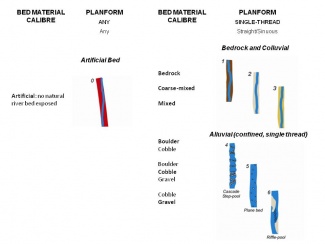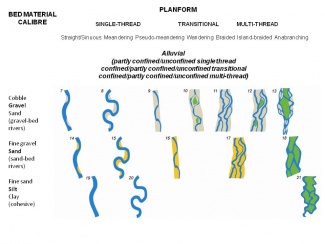Category:River Characterisation
River Characterization: Multi-scale Hierarchical Framework
Background
River characterisation is a process to determine the hydromorphological condition of a river. It investigates the current form and behaviour or a river, and how these have changed over time.
Rivers naturally adjust over time, but human interventions in the channel, floodplain and wider landscape have dramatically altered their form and behaviour. Rivers have been straightened and deepened for navigation, dammed for milling and water supplies, and embanked for flood protection; floodplain have been converted to agriculture and are now home to millions of people; and in the wider landscape forests have been cleared, marshes drained and sediment sources blocked. These transitions have been ongoing for hundreds to thousands of years in Europe, and consequently few, if any, pristine rivers remain.
Interventions that have occurred upstream, downstream or within the reach can influence its hydromorphology form and behaviour. For example, siltation in a lowland river reach can be caused by upstream changes in land use that increase the delivery of sediment to the channel (e.g. intensification of arable agiculture), impoundments downstream that produce a backwater effect that induces sediment deposition (e.g. dams and weirs), or modifications to the channel form or dimensions that reduce its capacity to transport sediment (e.g. channel deeping and widening). In addition, hydromophology responds in a delayed way to processes and interventions within the catchment. As a result, understanding hydromorphology at the reach scale requires an understanding of current and past processes and interventions at larger spatial scales. Without such a multi-scale understanding, management strategies are not fully informed and may not provide sustainable solutions.
Link to ecology and river restoration
A multi-scale approach to investigating hydromorphology inevitably focuses on geomorphological characteristics and the hydrological and geomorphological processes that influence those characteristics across time and space, but these are crucial for river ecology. Hydromorphological processes drive longitudinal and lateral connectivity within river networks and corridors, the assemblage and turnover of habitats, and the sedimentary and vegetation structures associated with those habitats. All of these processes and structures are relevant to the provision of habitats to support the entire life cycle of organisms including refugia, feeding, spawning etc. As a result, a process-based, multi-scale understanding of hydromorphology is essential for identifying degraded segments and reaches of river and for developing sustainable restoration approaches that are in sympathy with hydromorphological functioning from catchment to reach scales.
The Framework
The multi-scale hierarchical framework has been developed to be a flexible, open-ended approach to hydromorphological assessment that is in line with the Water Framework Directive. As a result, the framework is compatible with WFD, but being process-based and multi-scale it allows practitioners to delve into further detail on the underlying drivers of hydromorphology. For more information on the links to WFD see Hierarchical Framework and WFD.
The framework leads practitioners through a series of steps to delineate their river into spatial units; characterise the relevant hydrological, geomorphological and ecological charactersitics at each scale; and assess the current hydromorphological condition of the river and its sensitivity to change. It aims to make best use of currently available surveys (physical habitat, riparian habitat, morphological, hydrological regime and fish continuity, etc) and readily-available (mainly free) Pan-European data sets to guide users on:
- What information is required at which spatial scale in the context of the data sets that are available and any new data that may be needed.
- How the above information can be collected or generated, and how it can be analysed, in order to:
- Describe and, crucially, explain variation in river character and behaviour within a catchment.
- Provide users with a basis upon which they are able to understand past and present behaviour and predict how a particular reach might react to changes (e.g. removal of local engineering modifications, flow regime naturalisation, reinstatement of longitudinal sediment connectivity).
- Allow users to define potential, site-specific, “reference” conditions against which current hydromorphological and ecological condition could be assessed.
Rules of Engagement
Some ‘rules of engagement’ need to be born in mind before embarking on the application of the methodologies proposed in this framework:
- Involve a professional geomorphologist
- Carry out a field survey
- View the framework as a guide to an approach rather than a recipe book
- Accept that true reference reaches devoid of human influence do not exist, and instead,
- Focus on hydromorphological processes.
Hierarchy of spatial units
The hierarchy of spatial units within which relevant properties, forms and processes can be investigated to understand and assess hydromorphology and its potential impact on ecology is presented in Figure 1. The units are arranged in decreasing over of size (indicative spatial scale) and persistence (indicative time scale). The reach is the key spatial scale at which the mosaic of features found within river channels and floodplains (i) responds to the cascade of influences from larger spatial scales and (ii) is influenced by interactions and feedbacks between geomorphic and hydraulic units and smaller elements such as plants, large wood and sediment particles within the reach.
Three stages of river characterization
Stage 1: Delineation of spatial units
For catchment assessment and management purposes, the aim should be to subdivide the entire catchment into a complete set of units at all spatial scales from catchment to reach. In large catchments, this may not be possible, but it is necessary to subdivide the catchment to the scale of its major landscape units, after which representative subcatchments within each landscape unit can be analysed, delineating segments and reaches along the main channel and major tributaries for detailed analysis.
For assessment of a particular reach or segment, a minimum assessment needs to focus on the specific reach or segment and larger spatial units that contain and are immediately upstream of the reach or segment under consideration
Figure 2: Delineation of spatial units
For detailed information on the delineation methodology, please see the draft deliverable document File:Delineation.pdf.
Stage 2: Characterisation of spatial units
Characterisation of spatial units at the different scales attempts to draw together readily-available information, surveys, and data sets in ways that will promote understanding of the units and the linkages between them. Recommendations for characterisation take account of WFD requirements and make best use of existing pan-European and National data sets, including the outputs from physical habitat, riparian habitat, morphological, hydrological regime and fish continuity assessments, where they are available. Essential components of the characterisation are stressed
For detailed information on the characterisation methodology, please see the draft deliverable document File:Characterisation.pdf.
River Typology
Using information gained in the characterisation stage, river reaches are classified into one of 21 morphological types based on planform, morphological units, valley setting and channel bed sediment size.
Figure 3: Morphological typology or river reaches
For detailed information on the river typology, please see the draft deliverable document File:Typology.pdf.
Stage 3: Indicators
Key (primary) and secondary indicators are proposed at each spatial scale. Wherever possible, these are derived from information already assembled during characterisation. However, recommendations concerning new data collection and analyses are made where crucial information on these components is lacking. Indicators are used to support interpretation and process-based understanding of:
- Present condition of reaches and segments of river and floodplain
- Past condition of reaches and segments of river and floodplain
- Likely response of reaches and segments of river and floodplain to future scenarios.
For a preliminary outline of the indicators, please see the draft deliverable document File:4 Indicators.pdf.
Pages in category "River Characterisation"
The following 11 pages are in this category, out of 11 total.



